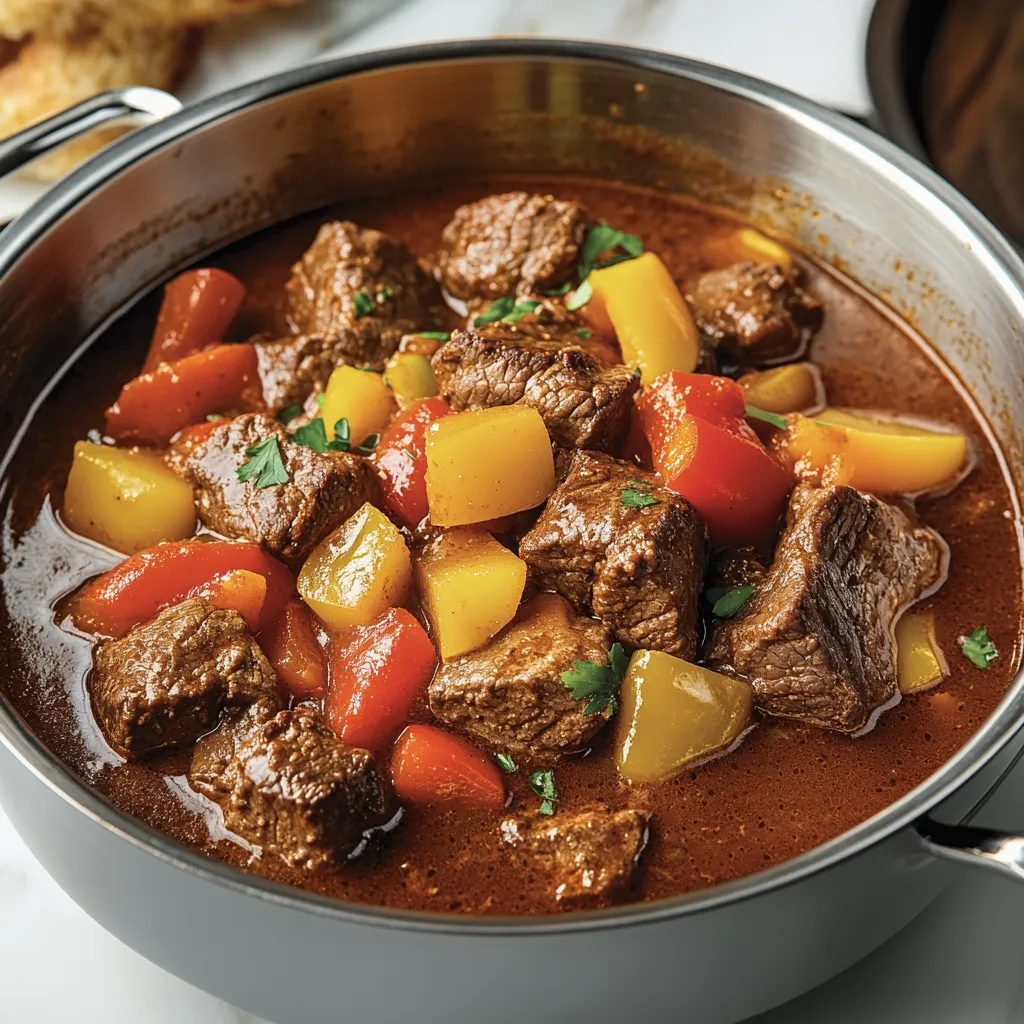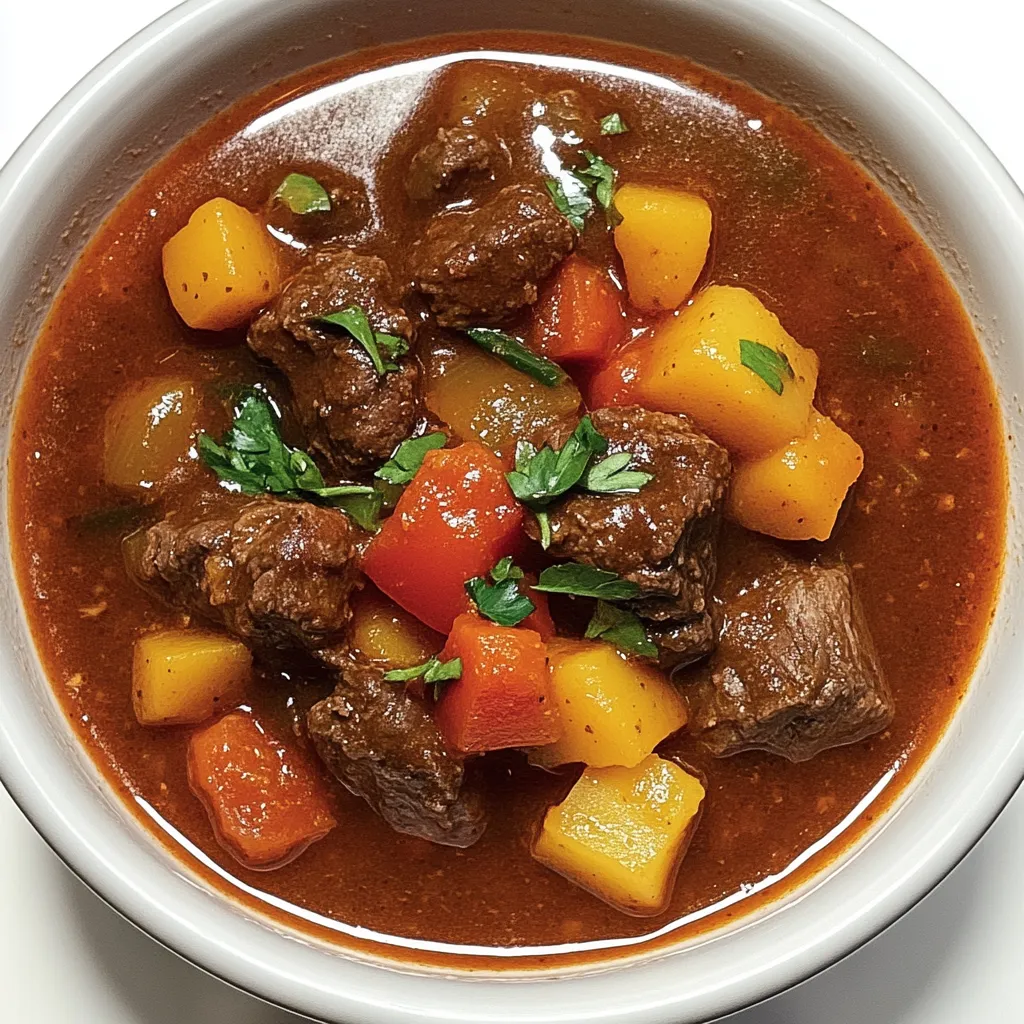 Pin it
Pin it
This flavorful German goulash brings a taste of old-school comfort straight to your table. You get melt-in-your-mouth beef braised low and slow, tasty paprika, loads of onions, and a sauce that's silky and rich. It’s the best for chilly weather—no wonder folks have loved it for ages.
Ingredients
- Beef chuck: delivers that tender bite and stays juicy—pick a piece with some fat for max flavor
- Onions: get soft and sweet when you let them cook down, the longer you sweat ‘em, the better they taste
- Red and yellow bell peppers: add a pop of sweetness and fresh taste—choose ones that look shiny and firm
- Garlic: gives extra depth and heartiness—always use fresh cloves
- Paprika powder: Hungarian style if possible for that real deal flavor, make sure it’s nice and bright red
- Caraway seeds: give a warm spice kick and help your tummy—fresh ground is best
- Tomato paste: pumps up the sauce color and adds gentle sweetness
- Red wine: brings a deep, fancy vibe—go with a bold wine if you can
- Beef stock: keeps the stew rich and hearty—homemade is always a win
- Marjoram: gives the dish that signature spice note—dried is totally fine
- Salt and pepper: dial up the flavor—go coarse if you want an extra punch
Step-by-step directions
- Final tasting and serving:
- Once it’s all cooked, taste the sauce and add as much salt and pepper as you like. Dish it up hot—it's awesome with potatoes, noodles, or just a hunk of rustic bread alongside.
- Add broth and beef:
- Now’s the time to toss the browned beef and its juices back in along with your stock. Sprinkle in marjoram, stir it all up, and let it bubble. Lower the heat, pop on a lid, and let it gently simmer for at least two hours, stirring here and there so nothing sticks.
- Pour in red wine:
- Next, splash in the red wine and use a wooden spoon to scrape all those tasty brown bits from the bottom—this packs in color and flavor. Let it reduce on low until about half the wine’s gone, around five minutes.
- Season things up:
- Time for the paprika, caraway, and that tomato paste. Mix it in real good and let those spices toast gently for a minute or two, so everything gets super aromatic and the paprika shines.
- Sauté onions and veggies:
- Sling the chopped onions into the same pot—let them go low and slow for like 10–15 minutes until super golden and soft. Stir every so often. Toss in the minced garlic and after a bit, the bell peppers. Keep it all moving for another three minutes so nothing catches.
- Sear your beef:
- Grab your beef, sprinkle on salt and pepper, then sear in hot oil in a big pot—in batches if needed. Brown all sides nice and deeply. This is key for that awesome roasted flavor. Set the beef aside on a plate for now.
 Pin it
Pin it
Good to know
You can totally make goulash ahead—it gets even tastier the next day
It freezes great
Good beef seriously makes a big difference
What gets me is how perfectly the bell pepper pulls it all together, and the smell always reminds me of grandma’s kitchen. My kid once devoured two huge bowls just for the sauce. Marjoram’s my secret hero—it balances everything out.
Storage and freshness
Pop goulash in the fridge in a sealed container, it’ll be good for three to four days. Warm it up slowly on low so the beef stays soft. Freezes nicely too—portion it out, freeze, then thaw overnight in the fridge and heat it back up gently.
Switch it up or swap stuff
Chuck in other veggies like carrots, mushrooms, or potatoes, no problem
Don’t want red wine? Use some grape juice with a splash of balsamic—tastes close enough
Missing marjoram? Oregano’s a solid stand-in
How to serve goulash like in Germany
Usually folks have goulash with boiled potatoes, noodles, or fresh crusty bread
If you’ve got guests, add a spoonful of sour cream or finely sliced pickles to kick it up
A crisp salad with cucumber or cabbage on the side keeps it fresh
A little backstory on German goulash
Goulash got its start in Hungary but found a home in Germany, turning heartier and meatier here than other spots. All those onions and peppers make the German take what it is. My family always made a big pot for every get-together—can’t imagine a party without it.
Frequently Asked Questions
- → Welches Fleisch eignet sich am besten für Gulasch?
Rinderschulter klappt super. Sie bleibt saftig und hat viel Geschmack, wenn man sie langsam schmort.
- → Kann ich das Gulasch auch ohne Rotwein zubereiten?
Ja, klar! Nimm einfach mehr Brühe oder Traubensaft und die Sauce wird trotzdem lecker.
- → Wie bekomme ich das Fleisch besonders zart?
Mach's langsam: Zwei Stunden oder länger auf kleiner Flamme bringen die perfekte Zartheit.
- → Welche Beilagen passen besonders gut dazu?
Kartoffeln, frisches Brot, Spätzle oder Nudeln sind klasse zum Tunken in die Sauce.
- → Kann man das Gericht im Voraus zubereiten?
Geht problemlos. Wenn's durchgezogen ist, schmeckt es am nächsten Tag sogar noch besser.
- → Kann ich andere Gemüsesorten hinzufügen?
Klar geht das! Karotten, Kartoffeln oder noch mehr Paprika bringen extra Farbe und Geschmack rein.
